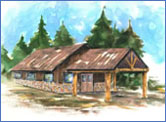
Green Home

| Scam Alert |
| About Tom Landis |
| The Owner Builder Coach |
|
|
|
RESOURCES |
|
FEATURE NEWS |
|
|
|
HOME BUILDING GUIDE |
| OWNER BUILDER COACH | SEMINARS | DOWN HOME RADIO | HOME BUILDING GUIDE |
|
From Tom's desktop...
Owners,
contractors, suppliers and designers point
Mold requires food, air, water and a temperature "Types of Mold and Fungi" Designing and building homes that exclude
mold spores Mold
requires moisture and a food source; so, if the "Controlling Mold Growth in the Home" During the design phase, there
are areas of concern that Proper
design solutions begin at the drawing board "Healthy and Affordable Housing: Practical
Recommendations for During the build phase,
there are construction measures that At
each phase of construction, each specialty contractor must be "Reduce
Mold Risks by Prodding Subs to Prevent Water Intrusion" There are routine, common-sense, maintenance steps you should take: * Maintain caulking around windows, doors, tubs, sinks. * Weather-stripping around doors/windows should be in place. * Clean/vacuum regularly around refrigerator, under sinks, hvac units. * Follow mfr's recommendations if you use a humidifier. * Check your home often for staining, standing water, mildew. * Keep water moving away from your house and clean gutters/downspouts. * Watch for plumbing leaks or flashing leaks. * Maintain tile grout to keep moisture from reaching inside wall/floor. * Fans in your kitchen, bathroom, laundry room should be utilized. "A
Brief Guide to Mold, Moisture, and Your Home"
Owners, contractors, suppliers
and designers share responsibility
Down Home Radio
Tom Landis
|

